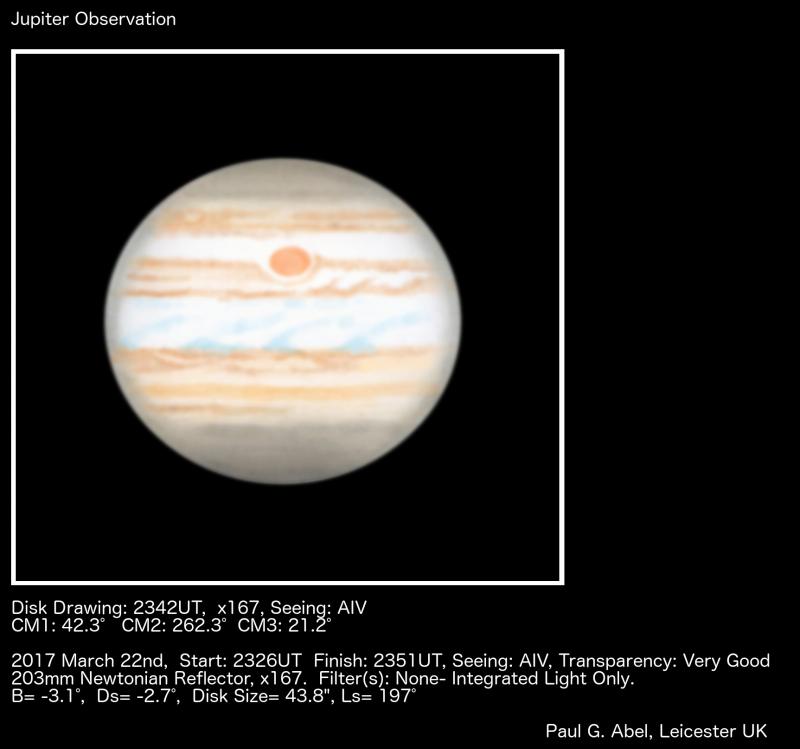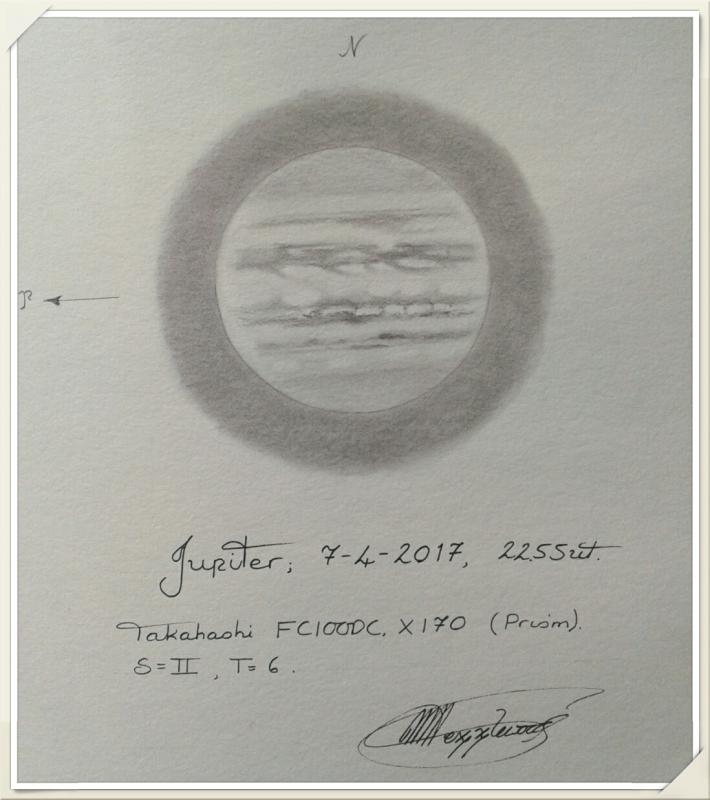2017 April 23
Observer’s Challenge: Jupiter’s Great Red Spot


Although the giant planet Jupiter has now passed opposition, it still continues to dominate our evening skies and we will be able to follow it for a few more months before it becomes lost in the sun’s glare as the time of solar conjunction occurs.
Jupiter’s vast size means that even small telescopes will reveal something of interest on the planet’s ever changing clouds. A view through a 3inch (75mm) telescope will show Jupiter as a somewhat flattened yellowish disk, crossed by two dark equatorial belts. Larger telescopes will reveal yet more belts which are separated by intermediate lighter zones. These belts are warmer regions deep inside the Jovian atmosphere, in contrast the bright zones are cold ammonia crystals high up in the atmosphere.
Since Jupiter is a gas giant, it has no solid surface and as a result the many storms which rage in the planet’s dynamic atmosphere can continue for many years – there being no land for them to hit and dissipate their energy. For over a hundred years now, the Jupiter section has been studying these storms as they provide important information about the extreme weather which occurs on Jupiter.

Although the spot fades, at the time of writing it is quite prominent and has a distinctly dark orange hue. I have seen the spot in a 4inch (100mm) telescope, and it is a splendid sight in a larger telescopes – the drawing above is a recent one which shows the Great Red Spot and the turbulence which follows it in the Southern Equatorial Belt.
Since we have the planet for a few more months, now’s a good time to get your telescope trained on Jupiter to see if you can see this ancient storm. The table below gives some of the best times when you can catch the spot – at these times it’s preceding edge will be on Jupiter’s central meridian (an imaginary line connecting Jupiter’s north and south poles).
If you’re having difficulty picking up the spot, try using a light blue filter – this will help darken the Great Red Spot and will help make it a little more obvious. Finally, don’t forget to record your observations – an image or a drawing is ideal, but a simple written account in a good old fashioned log book will also do. Make sure you record the date, time (UT), and telescope and magnification. I have been observing the Great Red Spot for over 20 years and never get tired of looking at it!
Date |
Time (UT) |
Time (BST) |
2017 April 25 |
2121 |
2221 |
2017 April 27 |
2259 |
2359 |
2017 April 30 |
0037 |
0137 |
2017 May 02 |
2206 |
2306 |
2017 May 04 |
2344 |
0044 (05 May) |
2017 May 07 |
2114 |
2214 |
2017 May 09 |
2252 |
2352 |
2017 May 12 |
2022 |
2122 |
2017 May 14 |
2200 |
2300 |
2017 May 16 |
2338 |
0038 (17 May) |
2017 May 19 |
2108 |
2208 |
2017 May 21 |
2246 |
2346 |
2017 May 26 |
2154 |
2254 |
2017 May 28 |
2333 |
0033 (29 May) |
2017 May 31 |
2103 |
2203 |
Paul G. Abel
To search for observations of Jupiter follow this link to the BAA Member Pages.
The BAA Jupiter Section website can be found here.
| The British Astronomical Association supports amateur astronomers around the UK and the rest of the world. Find out more about the BAA or join us. |
